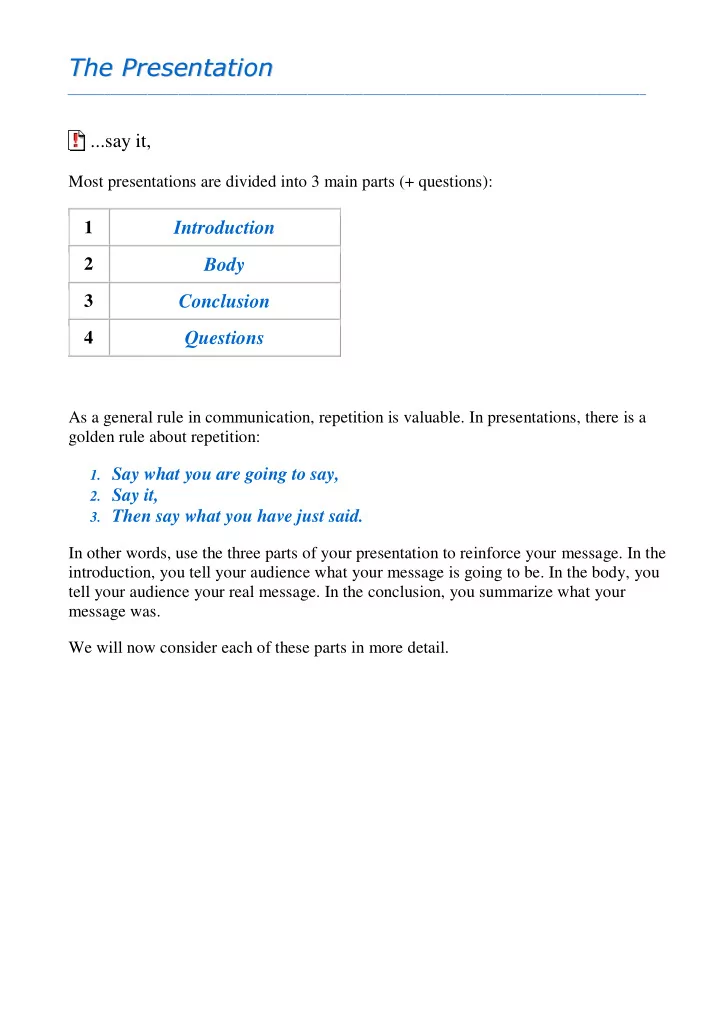

Th he e P Pr re es se en nt ta at ti io on n T _ __ __ __ __ __ __ __ __ __ __ __ __ __ __ __ __ __ __ __ __ __ __ __ __ __ __ __ __ __ __ __ __ __ __ __ __ __ __ __ __ __ __ __ __ __ __ __ __ __ __ __ __ __ __ __ __ __ __ __ __ __ __ __ __ __ __ __ __ __ __ __ __ __ __ __ __ __ __ __ __ __ __ __ __ __ __ __ __ __ __ __ __ __ _ ...say it, Most presentations are divided into 3 main parts (+ questions): 1 Introduction 2 Body Conclusion 3 4 Questions As a general rule in communication, repetition is valuable. In presentations, there is a golden rule about repetition: 1. Say what you are going to say, 2. Say it, 3. Then say what you have just said. In other words, use the three parts of your presentation to reinforce your message. In the introduction, you tell your audience what your message is going to be. In the body, you tell your audience your real message. In the conclusion, you summarize what your message was. We will now consider each of these parts in more detail.
In nt tr ro od du uc ct ti io on n I The introduction is a very important - perhaps the most important - part of your presentation. This is the first impression that your audience have of you. You should concentrate on getting your introduction right. You should use the introduction to: 1. Welcome your audience 2. Introduce your subject 3. Outline the structure of your presentation 4. Give instructions about questions The following table shows examples of language for each of these functions. You may need to modify the language as appropriate. Function Possible language Good morning, ladies and gentlemen Welcoming your Good morning, gentlemen Good afternoon, ladies and gentleman audience Good afternoon, everybody I am going to talk today about... Introducing your subject The purpose of my presentation is to introduce our new range of... To start with I'll describe the progress made this year. Then I'll mention some of the problems we've encountered and how we overcame them. After that I'll consider the Outlining your structure possibilities for further growth next year. Finally, I'll summarize my presentation (before concluding with some recommendations). Do feel free to interrupt me if you have any questions. I'll try to answer all of your questions after the Giving instructions presentation. about questions I plan to keep some time for questions after the presentation.
Signposting Function Language I'd like to start by... Let's begin by... Introducing the subject First of all, I'll... Starting with... I'll begin by... Well, I've told you about... That's all I have to say about... Finishing one subject... We've looked at... So much for... Now we'll move on to... Let me turn now to... Next... ...and starting another Turning to... I'd like now to discuss... Let's look now at... Where does that lead us? Analysing a point and giving Let's consider this in more detail... recommendations What does this mean for ABC? Translated into real terms... For example,... A good example of this is... Giving an example As an illustration of this is ,... To give you an example,... To illustrate this point... We'll be examining this point in more detail later on... I'd like to deal with this question later, if I may... Dealing with questions I'll come back to this question later in my talk... Perhaps you'd like to raise this point at the end... I won't comment on this now... In conclusion,... Right, let's sum up, shall we? I'd like now to recap... Summarising and concluding Let's summarise briefly what we've looked at... Finally, let me remind you of some of the issues we've covered... If I can just sum up the main points... Firstly...secondly...thirdly...lastly... Ordering First of all...then...next...after that...finally... To start with...later...to finish up...
Co on nc cl lu us si io on n C Use the conclusion to: 1. Sum up 2. (Give recommendations if appropriate) 3. Thank your audience 4. Invite questions The following table shows examples of language for each of these functions. You may need to modify the language as appropriate. Function Possible language To conclude,... In conclusion,... Now, to sum up... Summing up So let me summarise/recap what I've said. Finally, may I remind you of some of the main points we've considered. In conclusion, my recommendations are... Giving I therefore suggest/propose/recommend the following recommendations strategy. Many thanks for your attention. 3 Thanking your May I thank you all for being such an attentive audience. audience Now I'll try to answer any questions you may have. Can I answer any questions? Are there any questions? Inviting questions Do you have any questions? Are there any final questions? Questions Questions are a good opportunity for you to interact with your audience. It may be helpful for you to try to predict what questions will be asked so that you can prepare your response in advance. You may wish to accept questions at any time during your presentation, or to keep a time for questions after your presentation. Normally, it's your decision, and you should make it clear during the introduction. Be polite with all questioners, even if they ask difficult questions. They are showing interest in what you have to say and they deserve attention. Sometimes you can reformulate a question. Or answer the question with another question. Or even ask for comment from the rest of the audience.
Recommend
More recommend